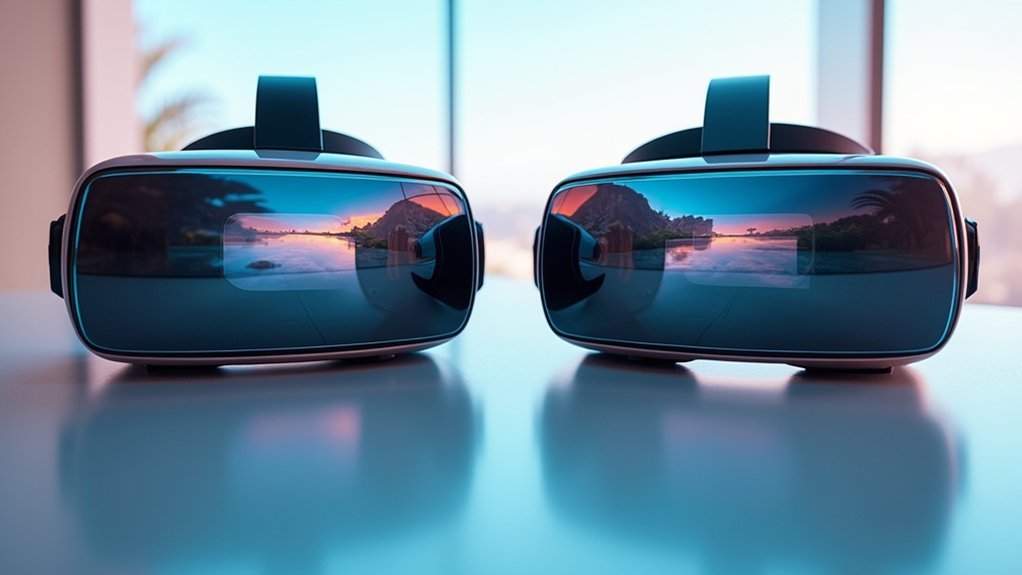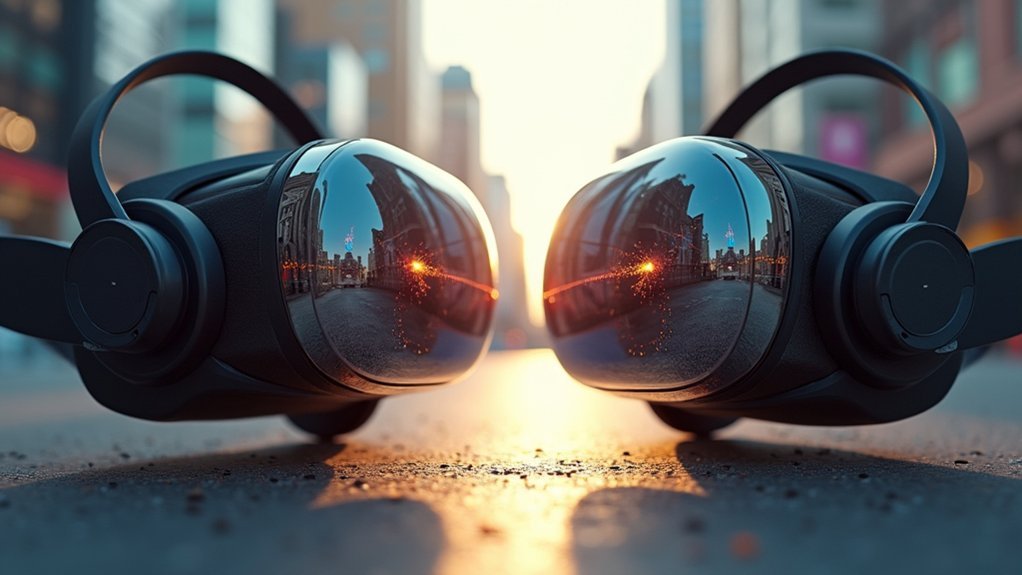You’ll find that wide FOV headsets at 140-210 degrees eliminate tunnel vision and create natural peripheral awareness, making VR experiences feel more realistic and immersive. However, narrow FOV headsets at 90-110 degrees offer sharper visual quality, better performance, and lower costs since they require less computational power. Wide FOV enhances presence but demands powerful hardware, while narrow FOV provides focused clarity with mainstream accessibility. Understanding these trade-offs will help you make the right choice for your specific needs.
Understanding Field of View in VR Technology

Immersion defines the VR experience, and field of view plays a pivotal role in achieving that sense of presence. When you’re comparing FOVs across different VR headsets, you’re fundamentally evaluating how much visual information reaches your eyes without head movement.
Your human vision naturally perceives up to 180 degrees, making this the gold standard for an immersive experience.
Human vision’s natural 180-degree perception sets the benchmark for truly immersive VR experiences that feel authentic and engaging.
The FOV you’ll experience depends on several interconnected factors. Headset design directly impacts the wide angle capabilities, while lens technology determines optical clarity across that range.
Your user facial geometry also affects the effective Field of View, as the distance between your eyes and lenses varies. Understanding these elements helps you make informed decisions when selecting VR headsets that’ll deliver the most natural, engaging virtual environments.
Human Vision Capabilities and VR Limitations
Your eyes naturally capture up to 180 degrees of vision without movement and can reach 270 degrees with full rotation, yet most VR headsets you’ll use today only deliver 90-110 degrees.
This significant gap creates a tunnel vision effect that cuts off your peripheral awareness, making virtual environments feel artificially constrained compared to real-world sight.
You’ll notice this limitation most when quick movements or edge-of-vision details become invisible, breaking the immersive experience your brain expects.
Natural Eye Movement Range
When you move your eyes naturally, you can perceive an impressive 180-degree field of view without any head movement, and this expands to roughly 270 degrees when you fully rotate your eyes. Your peripheral vision plays a significant role in creating an immersive visual experience that current VR headsets struggle to replicate.
| Vision Type | Horizontal FOV |
|---|---|
| Natural (stationary) | 180 degrees |
| Natural (full rotation) | 270 degrees |
| Standard VR headsets | 90-110 degrees |
| High-end VR (StarVR) | 210 degrees |
| VR limitation effect | Snorkel mask effect |
Most VR headsets create tunnel vision because they can’t match your human eye’s natural range. This limitation causes the snorkel mask effect, making experiences feel restrictive rather than truly immersive.
Current VR FOV Gaps
Several considerable gaps exist between human vision capabilities and current VR technology that directly impact your immersive experience.
Your eyes can perceive up to 270 degrees FOV with full rotation, but most VR headsets fall dramatically short. Popular models like the Oculus Rift and HTC Vive deliver only 110 degrees, creating a noticeable tunnel vision effect that restricts your peripheral view.
This limitation resembles wearing a snorkel mask, where you’re constantly aware of the visual boundaries. Even with recent advancements, most available headsets operate within the 80-110 degree range, considerably below human visual capabilities.
This FOV restriction directly undermines user immersion, preventing you from experiencing the natural visual freedom your brain expects in truly immersive environments.
Peripheral Vision Loss Effects
Although peripheral vision naturally guides your spatial awareness and movement in the real world, VR headsets strip away this essential sensory input through their restricted field of view.
You’ll experience peripheral vision loss when your headset’s FOV drops below 110 degrees, creating that dreaded snorkel mask effect that breaks immersion. This tunnel vision forces you to rely heavily on head movements to scan your environment, which feels unnatural and disorienting.
The severity of peripheral vision loss depends on your headset’s lens shape and screen technology.
Wide angle designs minimize these effects, but they come with significant design trade-offs. Manufacturers must balance FOV expansion against increased weight and cost, making truly immersive VR headsets a complex engineering challenge that directly impacts your virtual experience.
Current VR Headset FOV Specifications
You’ll find significant variation when comparing FOV specifications across today’s VR headsets, with measurements ranging from 90 to 210 degrees.
The StarVR/IMAX headset leads the pack at 210 degrees, while most mainstream options like the Oculus Rift and HTC Vive hover around the 110-degree standard.
Understanding these technical measurements helps you identify which headsets deliver the widest visual experiences for your specific needs.
Leading Headset FOV Rankings
When examining today’s VR headset market, the StarVR/IMAX headset dominates with an impressive 210-degree field of view that creates an unparalleled sense of visual immersion.
You’ll find the VR Union Claire ranking second with 170 degrees, delivering exceptional coverage for demanding applications. The Wearality Sky follows at 150 degrees, while GameFace Labs VR offers 140 degrees of visual experience.
Consumer-grade VR headsets like the Oculus Rift and HTC Vive both provide 110-degree FOV, representing the industry standard for mainstream users.
These rankings show you’ll get solid immersion without premium pricing. Budget-conscious options include PlayStation VR at 100 degrees and Google Cardboard at 90 degrees, though you’ll sacrifice some visual coverage for affordability.
Technical Measurement Standards
Field of view measurements in VR headsets follow standardized technical protocols that determine how manufacturers calculate and report their devices’ visual coverage.
You’ll encounter FOV specifications measured in degrees, with horizontal and vertical values often reported separately. These technical limitations affect how immersive your VR experience becomes, as wider FOV reduces the restrictive “snorkel mask” effect that breaks presence.
Current measurement standards reveal significant variations across headsets:
- Horizontal FOV: Ranges from 90 degrees (budget options) to 210 degrees (premium models)
- Vertical FOV: Often differs from horizontal measurements, requiring separate specification
- Rendered vs. Perceived: Actual user experience may vary from manufacturer claims
- Adjustable Features: IPD settings and lens positioning affect individual FOV perception
Understanding these standards helps you evaluate which headset delivers ideal perception capability for your needs.
Wide FOV Benefits for Immersive Experiences

While traditional VR headsets often create a restrictive “tunnel vision” experience, wider field of view technology transforms how you perceive virtual environments. Wide FOV delivers immersive experiences that eliminate the snorkel mask effect plaguing narrow-view systems.
| FOV Range | Visual Impact | Experience Quality |
|---|---|---|
| 90-100° | Restrictive tunnel vision | Limited immersion |
| 140-150° | Natural peripheral view | Enhanced presence |
| 170-210° | Expansive visual environment | Maximum realism |
| Narrow FOV | Claustrophobic feeling | Reduced engagement |
| Wide FOV | Freedom of movement | Superior user experience |
You’ll notice significant improvements in presence and speed perception with VR headsets featuring ideal FOV around 140 degrees. Systems like StarVR’s 210-degree range showcase how advancements in FOV technology create more compelling virtual interactions through dedicated GPU processing.
Narrow FOV Advantages for Focused Applications
Although wider fields of view capture attention for their immersive experience qualities, narrow field of view headsets offer distinct advantages that shouldn’t be overlooked in specialized applications.
You’ll find that narrow FOV designs excel at specific tasks by eliminating peripheral distractions and maintaining exceptional visual clarity. These lighter headsets reduce computational demands on your hardware, delivering performance improvement through higher frame rates.
- Enhanced Focus: Narrow FOV minimizes visual distractions, helping you concentrate on detailed work or training simulations
- Improved Comfort: Lighter headsets with simpler optics enable extended use without fatigue
- Better Performance: Reduced computational demands allow for high-quality visuals and smoother frame rates
- Maintained Immersion: You’ll still experience a strong sense of presence despite the restricted view through superior visual fidelity
Technical Challenges in FOV Implementation

When engineers attempt to expand field of view in VR headsets, they encounter a cascade of technical obstacles that complicate every aspect of design.
You’ll find that wider FOV implementations demand considerably more computational power, creating thermal management challenges that affect performance. These technical trade-offs force designers to balance FOV expansion against weight, battery life, and overall user experience quality.
The peripheral pixel degradation you experience with broader viewing angles compromises visual fidelity despite the larger viewing area.
Current limitations in essential technologies like eye tracking and varifocal lenses further complicate FOV implementation, requiring substantial advancements before mainstream adoption becomes feasible.
These constraints explain why consumer headsets haven’t achieved cinema-like viewing angles despite technological progress.
Performance Trade-offs Between Width and Quality
Because VR headsets must distribute finite processing power across their entire field of view, you’ll encounter inevitable compromises between FOV width and visual quality.
Wider field-of-view headsets like StarVR deliver enhanced immersion by eliminating tunnel vision, but they sacrifice display quality as manufacturers prioritize central vision over peripheral pixels.
These performance trade-offs manifest across different headset design philosophies:
- Enthusiast models like Pimax maximize FOV width without standalone thermal demands but require powerful external hardware.
- Consumer-focused options such as Meta prioritize affordability and mixed reality capabilities over premium visual quality.
- Balanced approaches like Valve Index offer adjustable features around 108 degrees FOV for broader compatibility.
- Future solutions will need advanced eye tracking and varifocal displays to resolve current width-versus-quality limitations.
Measuring and Testing Headset Field of View
Understanding these design compromises requires accurate measurement techniques that go beyond manufacturer specifications. When you’re measuring headset FOV, you’ll encounter variability based on your unique user geometry and facial structure.
Testing protocols typically involve placing markers in virtual environments to calculate the visible area from your perspective. This measuring approach has compiled data from 127 measurements across 24 different headsets, revealing significant discrepancies between marketing claims and actual performance.
Pimax headsets often show outliers that challenge advertised specifications. You’ll find that standardized testing methods are essential for achieving true immersive experience comparisons.
Your individual head shape directly impacts the FOV you’ll actually experience, making personal testing vital before choosing a headset for ideal virtual environments.
Future Developments in VR FOV Technology
While current VR headsets struggle to exceed 120 degrees horizontal FOV, breakthrough technologies are pushing boundaries toward true peripheral vision.
You’ll soon experience revolutionary advancements that’ll transform your VR sessions through sophisticated hardware innovations.
Companies are developing next-generation solutions that balance wide Field of View with essential performance requirements:
- Varifocal lenses that dynamically adjust focus distance, enhancing depth perception and reducing eye strain during extended use
- Advanced eye tracking systems that optimize rendering by focusing computational power where you’re actually looking
- Adjustable features like Valve’s approach, allowing you to customize FOV based on your specific needs and comfort preferences
- Mixed reality integration that combines expanded FOV with enhanced software capabilities for professional applications
These VR technology improvements promise markedly better user experience while managing thermal and computational challenges effectively.
Frequently Asked Questions
Which VR Headset Has the Best Field of View?
You’ll find the StarVR/IMAX headset offers the best field of view at 210 degrees. It’s considerably wider than competitors, providing you with the most expansive and immersive visual experience available.
What Is the Typical Field View You Can See in a Virtual Reality Headset?
You’ll typically see a field of view ranging from 90 to 110 degrees in most VR headsets. This creates some tunnel vision since your natural eyesight can perceive up to 180 degrees without moving.
What Is the Widest Field of View in Pimax 8KX?
You’ll get an impressive maximum horizontal field of view of up to 200 degrees with the Pimax 8KX, which you can customize based on your preferences and performance requirements.
What Is the Horizontal FOV of the HP Reverb G2?
You’ll experience a horizontal field of view of approximately 114 degrees with the HP Reverb G2. This wide FOV enhances your immersion during VR gaming and simulation experiences considerably.





Leave a Reply